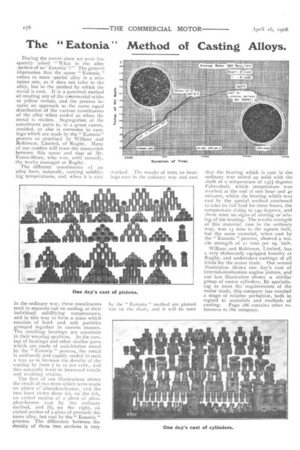The "Eatonia " Method of Casting Alloys.
Page 4

If you've noticed an error in this article please click here to report it so we can fix it.
During the recent show we were freiquently asked " What is the alloy spoken of as' Eatonia '?" The general impression that the name " Eatonia " refers to some special alloy is a mistaken one, as it does not refer to the alloy, but to the method by which the 'metal is cast. It is a patented method -of treating any of the commercial white or yellow metals, and the process insures an approach to the same equal -distribution of the various constituents -of the alloy when cooled as when the metal is molten. Segregation of the .constituent parts is, to a great extent, avoided, as also is corrosion in castings which are made by the " Eatonia" process as practised by Winans and Robinson, Limited, of Rugby. Many of our readers will trace the connection between this name and that of Mr. Eaton-Shore, who was, until recently, the works manager at Rugby.
The different constituents of an alloy have, naturally, varying solidifying temperatures, and, when it is cast in the ordinary way, these constituents tend to separate out on cooling at their individual solidifying temperatures, and in this way to form a mass which -consists of hard and soft particles grouped together in uneven masses. The resulting bearings are uncertain in their wearing qualities. In the casting of bearings and other similar parts which are made of anti-friction metal by the " Eatonia " process, the metal is uniformly and rapidly cooled in such a way as to increase the density of the casting by from 7 to m per cent., and this naturally lends to increased tensile and crushing strains,
The first of our illustrations Shows the result of two tests which were made on pieces of phosphor-bronze, and the two inset views show (a), on the left, an etched section of a piece of phosphor-bronze cast by the ordinary method, and (b), on the right, an -etched section of a piece of precisely the same alloy, but cast by the " Eatonia " process. The difference between the density of these two sections is very that the bearing which is cast in the ordinary way seized upsolid with the shaft at a temperature of 1371 degrees Fahrenheit, which temperature was reached at the end of one hour and 40 minutes, whilst the bearing which was cast by the special method continued to take its full load for three hours, the temperature rising to 149 degrees, and there were no signs of scoring or seizing of the bearing. The tensile strength of this material, cast in the ordinary way, was 53 tons to the square inch, but the same material, when cast by the " Eatonia " process, showed a tensile strength of 21 tons per sq. inch.
Winans and Robinson, Limited, has a very elaborately equipped foundry at Rugby, and undertakes castings of all kinds for the motor trade. Our second illustration shows one day's cast of internal-combustion engine pistons, and our last illustration shows a similar group of motor cylinders. By specialising to meet the requirements of the motor trade, this company has reached a stage of relative perfection, both in regard to materials and methods of casting. Page 186 contains other references to the company.


























